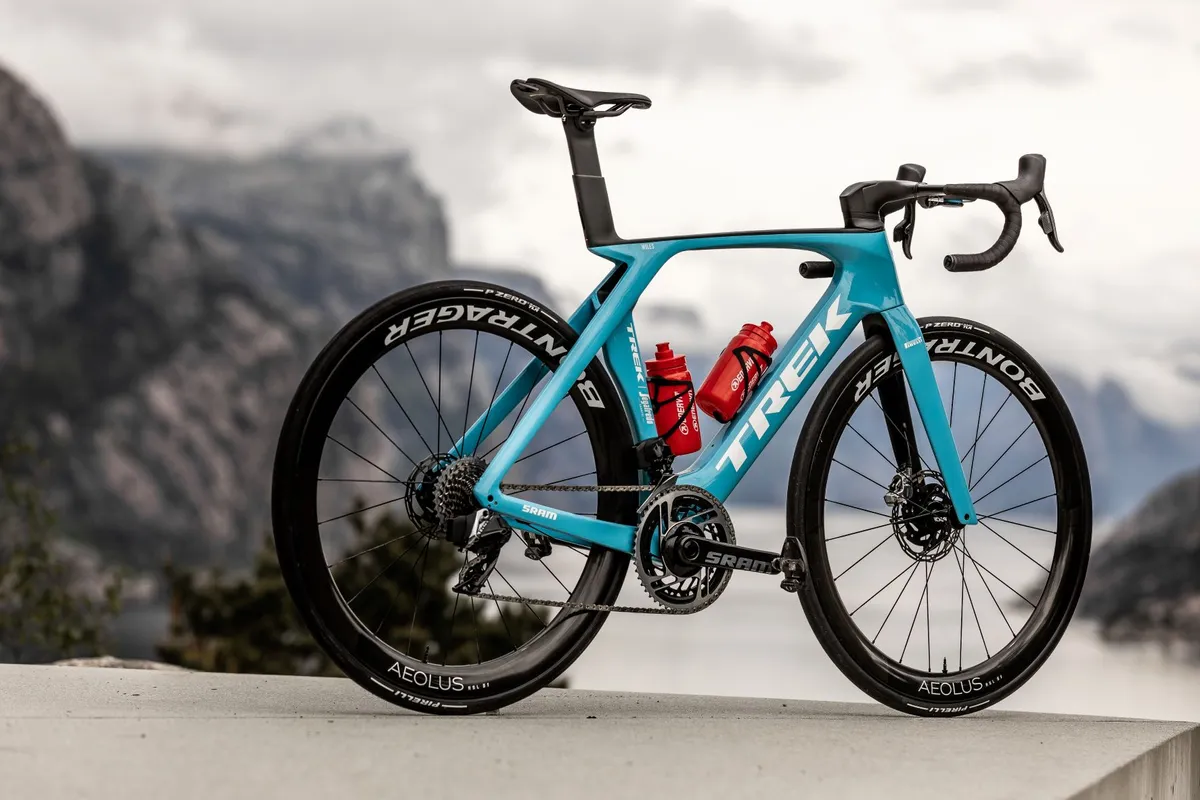BikeRadar ran an article in January 2021 investigating the root causes of rocketing bike prices, focusing specifically on the impact of the Covid-19 pandemic and Brexit.
The former’s effect on production and supply, combined with the latter’s banishment of tariff-free EU trade, created a perfect fiscal storm.
But where are we today? The winds of seemingly ever-increasing price rises appear to be sweeping over our shores, but recent price drops by Canyon and Specialized may point towards calmer seas.
Are these isolated instances of savings being passed on to the consumer, or does it hint at an imminent sell-off of excess stock, as has been predicted by some in the industry?
Here, we assess how much bike prices have increased since our last report and the reasons behind those increases.
We also outline whether there’s likely to be a reduction in prices, and why.
How much have bike prices increased, and why have they got more expensive?

According to the Bicycle Association (BA) – the national trade body for the UK cycling industry – the price of a bike with the same or similar spec has increased quite widely, from around 10 per cent to over 40 per cent depending on the discipline and other factors, between 2019 and 2022.
At the top end of that range, that means a bike priced at £1,000 in 2019 could now cost you £1,400.
In the US, a 2021 report from Bloomberg said the average amount paid for a bike had risen 27 per cent from the start of the year to March.
In addition to Brexit and the long-tail effects of the pandemic, new factors have pushed up average bike prices over the period covered by the BA’s data.
Here in the UK, Liz Truss’s 49-day tenure as prime minister severely rocked the boat, leading to an increase in inflation.
This weakened the pound, resulting in an overnight increase in the cost of importing goods.
The weaker pound directly impacted the UK cycling industry, which imports the majority of its goods.
While not a new factor, Brexit continues to cause headaches for bike brands too.

As early as 2021, brands increased prices for UK customers, citing Brexit as a key reason behind price hikes. Rose went as far as exiting the UK market altogether.
Dominic Thomas, the co-founder of Fairlight, said increased transportation costs and additional admin caused by Brexit were key factors that forced the brand to increase prices of some of its models by 10 per cent in 2022.
“Post-Brexit, we should have been able to continue transporting our EU-manufactured frames in and out of the EU without incurring duty costs.
“In reality, despite filling in the required paperwork 'to the T', we were charged up to 100 per cent duty for products that should be 0 per cent.”
Globally, Russia’s war in Ukraine also contributed to rising energy costs, increasing the cost of manufacturing.
The pandemic-prompted boom in cycling also played its part in keeping prices stubbornly high.
The number of bikes sold rose 27 per cent between April and September 2020, with electric bike sales more than doubling.
With enormous demand outstripping supply in some areas (no one can forget the great 11-speed chain shortage of 2021), there was little incentive for brands to cut prices, reducing the number of deals available to consumers.
Though lifted recently, China’s zero Covid policy put enormous strain on manufacturing and logistics across all sectors.
Mark Sutton, editor of Cycling Industry News, also highlights China’s rhetoric on bringing Taiwan under its control as a potential area of concern for 2023 and beyond.
Taiwan is a key manufacturing hub for the cycling industry. Any disruption to trade could especially “impact the electric bike industry quite severely given that Taiwan is a key electronics supplier to the world”.
Are bike prices going to start dropping?
While it would be foolish to suggest everything is rosy on the geopolitical front, 2023 is, on the face of it, shaping up to be a less turbulent year for the cycling industry.
While the war in Ukraine continues to rumble on grimly, energy costs have largely normalised.
A successful vaccine programme has seen us enter something of a ‘post-pandemic’ era in the West.
Provided a snap general election (or another Conservative leadership election?) doesn’t throw things off kilter, the political situation in the UK is also unlikely to cause another run on the pound.
Could this more stable outlook manifest itself in reduced prices for customers? Let’s take a closer look.
Demand vs supply

Many are predicting a slowdown in demand for bikes may contribute to an industry-wide decrease in prices.
According to a BA report, UK bike sales are down by a quarter against Covid levels.
The first half of 2022 saw market volume and value drop by 28 per cent and 26 per cent respectively, compared to the same period in 2021.
The report says 2022 might be a “low water mark” of a post-Covid slump, with recovery likely to be slow and subdued by global and local market forces.
This dip in sales comes despite a sustained 33 per cent increase in the number of people cycling compared to pre-pandemic levels, according to Department for Transport figures cited in the BA’s report.
This figure has cranked up to 39 per cent since March, when fuel prices started to increase after the Russian invasion of Ukraine.
This has led some to speculate that bike brands may have overestimated market demand, leading to a growing stockpile of bikes.
Interestingly, some cycling disciplines continue to see strong sales and, in some cases, growth.
The BA’s Market Data Service showed the average selling price (the average price of each bike sold, rather than the average asking price) increased by more than 40 per cent between 2019 and 2022.
John Worthington, the head of insights at the BA, says demand among cycling hobbyists for higher-end carbon road or mountain bikes has contributed to this.

While the BA’s report shows ebike sales have plateaued, electric cargo bikes are up 37 per cent to around 10,000 units sold between January and May 2022, compared to 12 months previous.
This shift in buying habits has contributed to excess stock, “particularly around entry-level/mid-tier”, says Worthington.
This sentiment is echoed by others.
Speaking to Bloomberg, Brompton CEO Will Butler-Adams claimed outright that “the industry has over-ordered on bikes”.
According to the Financial Times, Goldman Sachs issued a sell recommendation for Shimano stocks in October, predicting an “impending correction in component orders from bike-makers”.
Writing on Twitter, cycling journalist Carlton Reid also claims his sources are predicting excess stock will result in “carnage… worse than the BMX/MTB/road sector crashes of previous years”.
Worthington predicts retailers and brands will have to offer heavy discounts to shift inventory, creating “some downward pressure on average selling prices across the market as a whole”.
There are early indications that a great sell-off could be afoot, though no manufacturer has specified excess stock as the root cause behind this.

Aaron Budd from Canyon UK said “many aspects [influence] final pricing – e.g. raw materials, exchange rates, customs and delivery charges, etc – and we constantly review them.
“In this case, it’s simply meant we can drop our pricing.”
Canyon also added this was a permanent price decrease, rather than a limited-time sale.
Specialized has also cut the prices of some models in Canada, citing “significant changes in the economy” in an Instagram post.
In a statement to BikeRadar, Specialized said it was “excited with the work our worldwide team is focused on that will benefit riders”, adding there was “more information to come”.
None of this is great news if you’re a retailer, but it does mean you could soon be able to find yourself a discount – or, at least, pricing closer to what we would have expected a few years ago.
Sunnier shipping forecasts

Looking outside of the cycling industry, the price of shipping products increased enormously during the pandemic.
The cost of sending a 40ft shipping container from China to the west coast of the USA peaked at more than $20,000 in September 2021.
This had a knock-on effect on the cycling industry because most inventory is shipped by sea worldwide from manufacturing bases in Asia.
Prices became so high that some brands began shipping products by air freight because it wasn’t much more expensive and it was much quicker.
However, the price of shipping a 40ft container from China to the west coast of the USA has stabilised at around $1,400 as of January, and these savings have been passed on to manufacturers.
“I have been told by someone senior in the industry that inbound costs have returned more or less to pre-pandemic levels,” says Worthington.
So, will bike prices drop?

While any unforeseen global factors could throw things off course, we think the industry will see a short-term reduction in average bike prices.
If brands are sitting on piles of excess stock in the low to mid-range, you’re likely to see generous discounts on 2022 bikes, particularly as new models are released closer to the summer.
However, Worthington believes long-term price reductions are unlikely.
Although the pound has risen since the autumn slump, “there is little expectation across the industry that prices for newly imported bikes are likely to fall much in the near-term”.
He adds that, while there are a growing number of sales promotions across the industry, “there is no sign in the data as yet that average selling prices are really dropping”.
Supply has improved at the premium end, but there are still shortages, says Worthington. This, coupled with resilient demand for higher-end carbon road and mountain bikes, means significant long-term reductions at this end of the market feel unlikely.
At the very top end, we expect manufacturers will continue to outdo each other to charge ever-more outrageous prices for halo bikes (a £14k hardtail, anyone?).
Worthington concludes that “the market faces a turbulent and challenging year ahead, with subdued consumer demand affecting the whole industry”.
Whether this will translate into a sustained bust after a few booming years remains to be seen.
